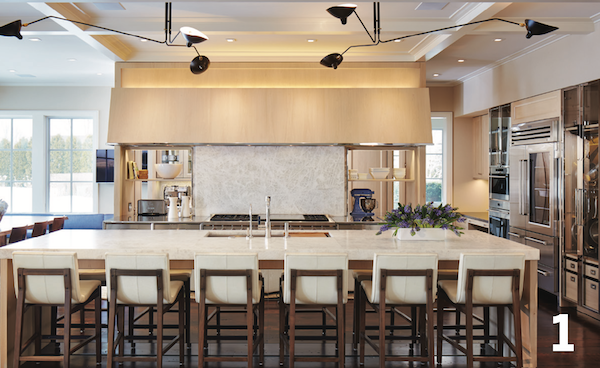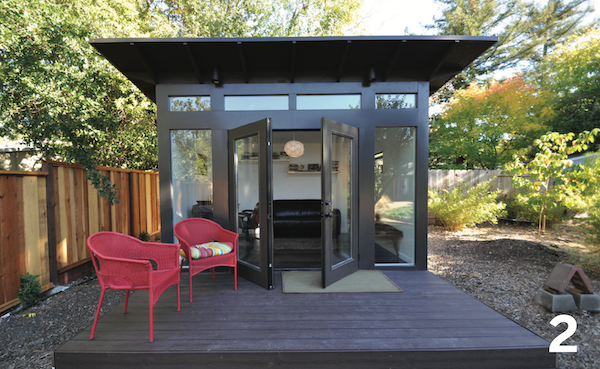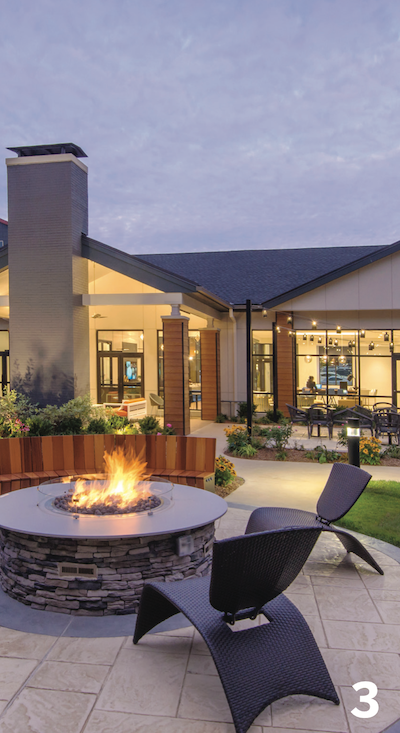
Key Takeaways:
- Layered kitchens make it easier to show off culinary creations while concealing mess and clutter.
- Outdoor warming features extend the possibility of safer socializing.
- Sheds are no longer just for storage. Expanding in size and complexity, they offer extra living space for adult children or home offices.
The design trends that will dominate in 2021 reflect the ways the COVID-19 pandemic has upended people’s lives, driving them to create a home that’s a safe place to relax, work, study, and socialize. While the following three enhancements address practical needs, there are plenty of high aesthetics—and a healthy dose of joy—in these new visions for the lives people are living indoors and outdoors. These are the kinds of upgrades that may just have people choosing to stay put, even when it’s safe to venture out more freely.
1. Two-for-one “Layered” Kitchens

Even before the pandemic, some homeowners with an open-plan layout found that increased exposure and family togetherness posed a downside in the kitchen work area: piles of dirty dishes, cluttered countertops, and other unsightly messes. Leave it to trendsetters to develop a solution for those with ample space and funds: two kitchens in one. Mick De Giulio of de Giulio Kitchen Design in Chicago calls it a “layered kitchen” with separate “work” and “living” zones. Cheryl Kees Clendenon of In Detail Interiors in Pensacola, Fla., refers to it as having a “prep and show kitchen.” In the work area, typically at the back and concealed by a door, wall, or hall, serious cooking and cleanup take place. The area may be part of a large laundry or utility room and might also be used by caterers (when entertaining returns with gusto), Clendenon says.
In contrast, the living or show kitchen at the front remains open, designed to display culinary creations in a clean, uncluttered way. It’s where a golden-brown turkey would come out of the oven before being carried to the back for carving. Some homeowners may also designate one kitchen for special-requirements cooking such as gluten-free prep, which a client of Clendenon’s requested. Or some may want to make space for a dedicated beverage center with a coffee station, refrigerated drawers, and a wine cooler to meet needs from morning to night, De Giulio says.
2. Flexible, Prefabricated Sheds

Sheds, once used primarily to store sports equipment and garden paraphernalia, have evolved into a common home addition. Some homeowners use them as overflow storage instead of paying for an expensive off-site facility. Others seek larger and better outfitted models as accessory dwelling units for people because more municipalities are approving ADUs. They’ve become dwellings for returning adult children and short- and long-term renters, quiet work-from-home quarters, and escapes for recouping sanity—hence the new moniker “the sanity shed.”
Rather than have an architect or contractor design and build a shed from scratch—which can be pricey and time-consuming and which often requires a building permit—homeowners can find more affordable, off-the-shelf options on the market, some of which can be customized. Boulder, Colo.–based Studio Shed has experienced explosive growth during the pandemic. The company offers prefabricated, sustainable designs that vary by size (from 64 to 256 square feet), color, door and window placement, finishes, and price ($11,000 and up). Because of the increase in gardening during the pandemic, the company offers its “Studio Sprout” greenhouse ($14,250), while customers’ most popular choice is a functional home office (about $25,000). Some municipalities looking to spur affordable housing in a shorter time frame offer preapproved plans for expanded sheds that can serve as modest dwellings, says architect Brian O’Looney of Torti Gallas + Partners in Washington, D.C., in his new book, Increments of Neighborhood.
3. Outdoor Warming Features

As temperatures fell, homeowners wanted to extend safe, outdoor socializing with family and friends in the time of COVID-19. “Everybody wanted to turn their backyard into an oasis to be able to eat safely and talk,” says landscape architect Clara Batchelor of CBA Landscape Architects in Cambridge, Mass. Many, including residents of multifamily buildings with shared outdoor space, want to keep doing so throughout winter. Two features that make fresh-air living in chilly evening weather pleasant are fire pits and patio heaters. They offer warmth from infrared electric heat, propane, or real wood-burning fires.
Local authorities are revising codes and ordinances to ease requirements pertaining to fire features, says architect Gary Kane with The Architectural Team in Chelsea, Mass. While fire pits have been popular for years, they’ve become more stylish, now available in different shapes, sizes, materials, weights, and prices. One design that grabbed attention early in the pandemic was Solo Stove’s portable “Bonfire” pit that uses logs but is smokeless. Hybrid models use gas and burning logs, says landscape architect Marc Nissim of Harmony Design in Westfield, N.J. Patio heaters are a newer home addition, inspired by restaurants using them to coax diners to eat outdoors. Using a variety of heating fuels, some are designed to stand alone and others mount on a wall or ceiling, says landscape designer Michael Glassman of Michael Glassman & Associates in Sacramento, Calif.
See more design trends for the year ahead.
